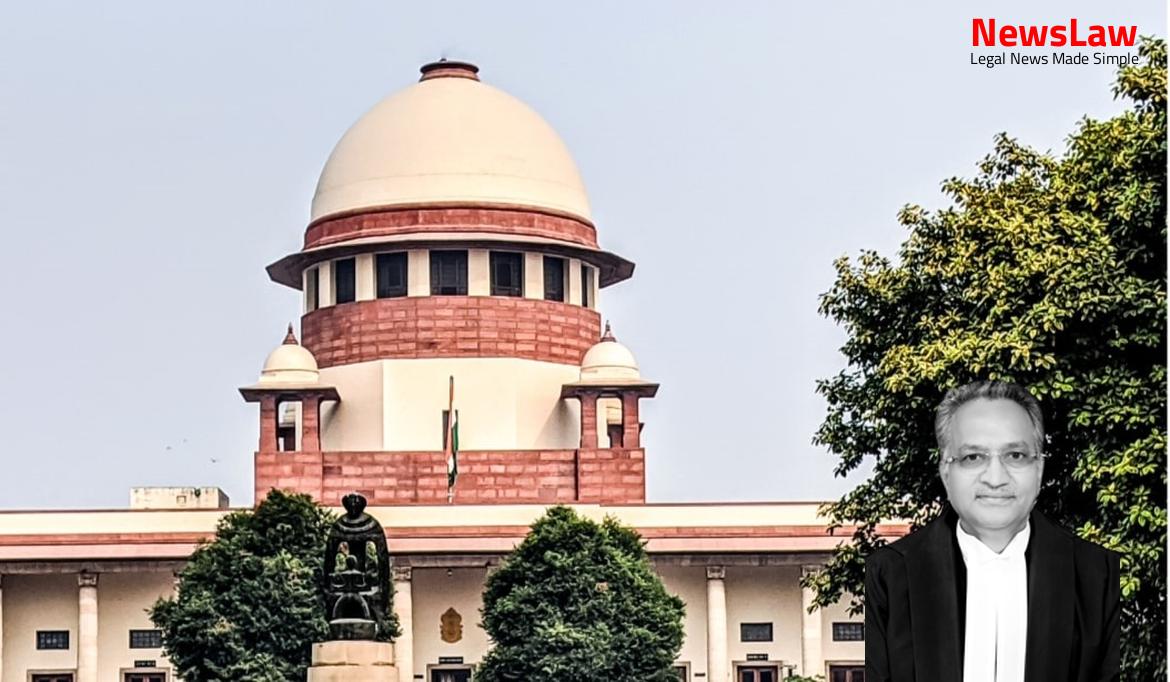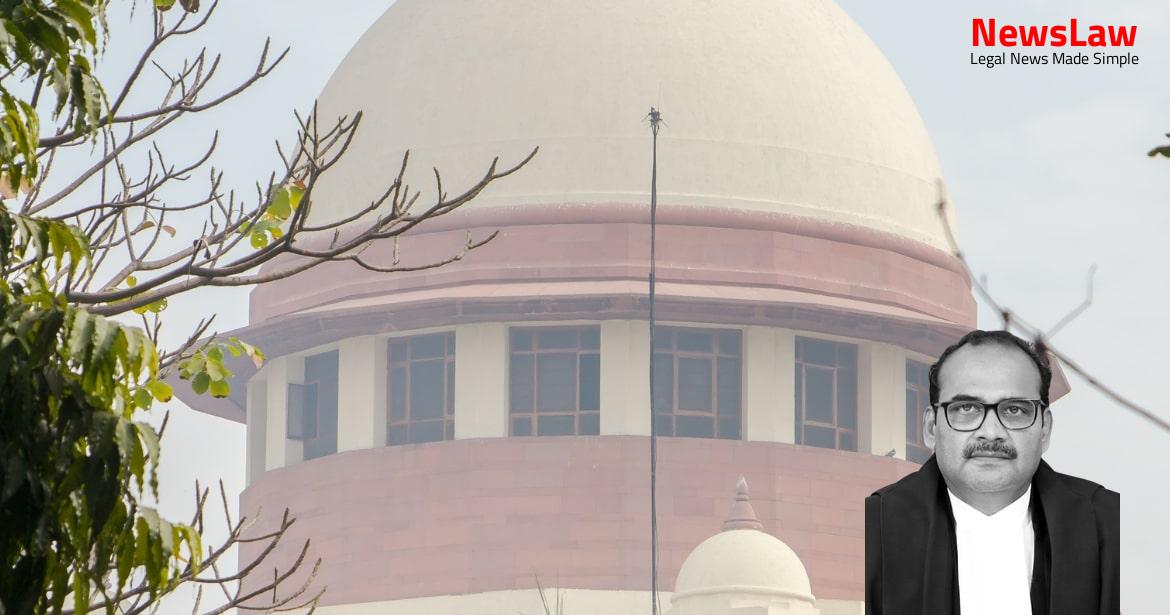Explore the complexities of legal analysis in a recent court judgment focusing on the interpretation of the Limitation Act in various legal proceedings. The court’s detailed analysis of waiver, estoppel, and adherence to procedural timelines sheds light on the intricacies of the law and highlights the importance of legal precision and strategic arguments.
Facts
- The appeals were opposed by Kalpraj and RP on the ground of being filed beyond the limitation period prescribed under the I&B Code.
- On 23.01.2020, appellants made payments to Ricoh Company Limited and NRG Group Limited for the transfer of shares.
- Mr. Krishna Chamadia was confirmed as the Resolution Professional by the CoC on 15.6.2018.
- On 27.12.2019, the share capital of the company increased to INR. 100,00,00,000/-.
- Appellants paid CIRP costs amounting to INR. 2,65,68,000/- on 30.12.2019.
- KIAL filed an application on 14.3.2019 objecting to the plan of Kalpraj after RP applied for approval of the plan.
- In the CoC meeting on 30.1.2019, revised resolution plans were requested from all applicants.
- KIAL submitted revised plans twice and later objected to the plan of Kalpraj on 14.12.2019.
- The plan of Kalpraj was approved by CoC in the meeting held on 13/14.2.2019.
- NCLT approved the resolution plan of Kalpraj as per Section 14 of the I&B Code.
- RP invited EOI for resolution plans on 9.7.2018 and rejected M.A. No 691 of 2019 while approving Kalpraj’s plan.
- KIAL filed M.A. No 1039 of 2019 objecting to the plan of Kalpraj.
- NCLT allowed M.A. No.691 of 2019 and rejected M.A. No.1039 of 2019.
- KIAL appealed before NCLAT on 18.2.2020 against the decisions of NCLT.
- NCLAT entertained the appeals filed beyond limitation and affirmed NCLT’s decision.
- NCLT approved the plan on 28.11.2019, leading to the implementation steps by Kalpraj.
- Kalpraj expended a total amount of Rs. 300 crores for the plan implementation.
- Various steps were taken by Kalpraj post the NCLAT’s order on 5.8.2020.
- On 01.01.2020, the appellants made payments to non-related party operational creditors of the Corporate Debtor.
- NCLAT set aside the orders passed by NCLT in M.A. No. 1039 and M.A. No. 691 of 2019.
- Kotak Investment Advisors Limited (KIAL) filed M.A. No. 1039 objecting to the approval of the resolution plan by Kalpraj.
- The District Judge found the application to set aside the award as time-barred.
- The Division Bench of the Karnataka High Court ruled that Section 14 of the Limitation Act was applicable to the application submitted under Section 34 of the Act.
- NCLAT disagreed with objections raised by respondents regarding limitation and found a breach of I&B Code provisions by RP and CoC.
- NCLAT allowed the appeals filed by KIAL against the orders passed by NCLT.
- High Court dismissed the Writ Petition filed by KIAL stating the availability of an alternate remedy of filing an appeal before NCLAT.
Also Read: Presumption of Genuine Endorsements in Cheque Case
Issue
- The issue raised in the judgment pertains to the appeals filed by KIAL before NCLAT.
- The key question is whether the appeals were filed within the limitation period.
- This issue is crucial for determining the validity of the appeals and their admissibility before NCLAT.
Also Read: Medical Negligence and Compensation: A Landmark Decision
Arguments
- KIAL, represented by Senior Counsel Dr. Abhishek Manu Singhvi, argued that the proceedings conducted by NCLT were in breach of natural justice, as the matter was heard by a single Member but the orders were passed by a Division Bench.
- Dr. Singhvi emphasized that the High Court’s dismissal of the writ petition and suggestion for an alternate legal remedy was based on a detailed order, indicating that KIAL’s approach to the High Court was justified and in good faith.
- He contended that the High Court could entertain a petition under Article 226, even if an alternate remedy existed, especially in cases where natural justice principles were violated during proceedings.
- Dr. Singhvi also pointed out that KIAL had participated in proceedings before a two-Member bench without objection, indicating that any later challenge to the proceedings lacked merit.
- The argument centered around the application of Section 14 of the Limitation Act and the importance of interpreting it liberally to advance justice.
- Overall, Dr. Singhvi highlighted that KIAL’s actions were guided by a bona fide pursuit of legal remedies and that the challenge to CoC’s decision was based on valid legal grounds.
- RP requested KIAL to submit amended Resolution Plan by 3.00 p.m. on 1.2.2019
- Email mentioned that CoC reserves the right to not consider plan received after the deadline
- KIAL submitted revised plan as per the deadline
- RP replied on 11.2.2019 stating that plans submitted after due date could be considered for value maximization
- KIAL objected to Kalpraj’s participation immediately after filing by RP before NCLT
- KIAL continued to object to Kalpraj’s plan approval at various stages
- KIAL’s objections were raised without delay and consistently
- Kotak Bank’s actions cannot bind KIAL as they are separate entities
- KIAL objected to Kalpraj’s plan acceptance upon discovery of timeline breach
- KIAL’s objections were based on principles of natural justice being breached
- KIAL took steps to challenge Kalpraj’s participation through proper channels
- Kotak Bank’s concurrence with CoC counsel’s view doesn’t bind KIAL
- KIAL’s Resolution Plan almost identical to Kalpraj’s
- KIAL’s conduct did not amount to acquiescence or waiver
- KIAL’s revised plans were submitted under compulsion to avoid ousting from consideration
- RP and CoC’s actions showed favoritism towards Kalpraj
- NCLAT’s considerations of the case were appropriate
Also Read: Remand of Writ Petition for Restoration and Decision on Merits
Analysis
- The issue at hand pertains to the decision of the NCLAT in interfering with the acceptance of the resolution plan of KALPRAJ by the CoC.
- Sections 30 and 31 of the Insolvency and Bankruptcy Code (I&B Code) are referenced to analyze the submission and approval of resolution plans.
- Waiver is described as the abandonment of a right, either express or implied from conduct.
- Section 61 and 238A of the I&B Code outline the appeals process and the applicability of the Limitation Act, 1963.
- An appeal can be filed against an order approving a resolution plan on specific grounds.
- The provisions of the I&B Code govern the appeals process before the National Company Law Appellate Tribunal (NCLAT).
- The judgment in the case of Popular Construction Co. was considered by the Court in Consolidated Engineering Enterprises.
- The issue of applicability of Section 14 of the Limitation Act to an application under Section 34(3) of the Arbitration Act was deliberated upon.
- The appellant in Consolidated Engineering Enterprises was engaged in civil engineering construction.
- The court distinguished the judgement in Parson Tools and Plants based on the limitation period provided by the U.P. Sales Tax Act.
- The object of every legislation is to advance public welfare.
- The Court emphasized the importance of waiver and the need for a party to be aware of the relevant facts and their legal rights for waiver to be considered valid.
- Waiver is contractual and may constitute a cause of action, differing from estoppel which is a rule of evidence.
- The Court clarified the difference between waiver and acquiescence, stating that waiver involves knowing abandonment of a legal right.
- The principle of waiver is akin to the principle of estoppel but requires an agreement between the parties and awareness of legal rights.
- The Court considered the applicability of Section 14 of the Limitation Act to quasi-judicial forums and emphasized the importance of context in interpretation.
- The judgment in the case of Neeraj Jhanji (supra) is not applicable to the present case.
- The judgment in the case of Singh Enterprises (supra) was about the applicability of Section 5 of the Limitation Act to an appeal under Section 35 of the Central Excise Act, 1944.
- The judgment in Singh Enterprises case deals with Section 5 and not Section 14 of the Limitation Act, hence does not support the appellants’ case.
- The decision of NCLAT dated 5.8.2020 does not stand the scrutiny of law.
- Subsequent approval of the resolution plan of KIAL by CoC becomes non-est in law as it was only to abide by the directions of NCLAT.
- The decision of CoC dated 13/14.2.2019 is based on its exercise of ‘commercial wisdom’.
- The decision taken by CoC dated 13/14.2.2019, in accordance with its ‘commercial wisdom’ and duly approved by NCLT, will prevail.
- For a long period, there was no restraint on the implementation of the resolution plan of Kalpraj, duly approved by NCLT.
- Various steps have been taken by Kalpraj for the implementation of the plan during this period.
- NCLAT acted in excess of jurisdiction by interfering with the conscious commercial decision of CoC.
- CoC approved the resolution plan of KIAL on 13.8.2020 in pursuance of the order dated 5.8.2020 passed by NCLAT, but it was not justified in interfering with the previous decision taken by CoC.
Decision
- NCLAT is directed to decide the appeal of Fourth Dimension Solutions Limited expeditiously within two months
- The appeal filed by Fourth Dimension Solutions Limited against the order of NCLT is still pending before NCLAT
- Various dates on which the matter was adjourned are mentioned for reference
- The specific timelines for filing the appeal as per I&B Code are highlighted
- Orders passed by NCLT dated 28.11.2019 are restored and maintained
- Various Civil Appeals are mentioned which are considered in the judgment
Case Title: KALPRAJ DHARAMSHI SUCCESSFUL RESOLUTION APPLICANT Vs. KOTAK INVESTMENT ADVISORS LIMITED (2021 INSC 173)
Case Number: C.A. No.-002943-002944 / 2020



